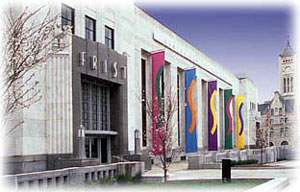
Frist Center for the Visual Arts
The Frist Center for the Visual Arts opened in April 2001 in the former U.S. Post Office building in downtown Nashville. Constructed in 1933-34, the building, an example of Depression-era “Stripped Classicism,” was designed by the local architectural firm Marr and Holman. It was listed on the National Register of Historic Places in 1984. The Frist Center serves as an important cultural center in Nashville, offering visitors a variety of visual arts exhibitions and educational programs.
The decision in 1931 to build a new building for post office operations rather than the initial plan to simply add onto the existing space in the Customs House allowed for the construction of a building on a parcel adjacent to Union Station, the main downtown railroad terminal. On November 5, 1931, the Marr and Holman firm was chosen to design the new post office. Following the specifications of the U.S. Treasury Department’s Office of the Supervising Architect, their final plans were approved in the spring of 1933 and Frank Messer and Sons of Cincinnati were hired as contractors. The post office opened for business on November 26, 1934.
Built as a post office during the New Deal period, the building became an architectural and civic icon in Nashville while serving as a tool for recovery from the economic hardships of the Depression. Throughout the period of construction, the project provided jobs for hundreds of unemployed workers and helped to stimulate the economy. In addition, the design of the building displays the effort of the federal government to impose a sense of order and rationality through the construction of public buildings.
The Stripped Classical style employed by the Office of the Supervising Architect looked to Classicism for an image of permanence and strength while using streamlined forms to suggest the progress of the modern period. Decorative cast-aluminum elements include national icons such as eagles; images of progress including the airplane, locomotive, ship, and automobile; and depictions of tools to symbolize industry, science, and agriculture. These symbols of civic and cultural ideals, as well as the form and design of the building, expressed a hope for economic revival to the American public.
The building served as Nashville’s main post office until 1987 when the central distribution operations moved to the airport, the airplane having replaced the train as the major mode of transportation for the mail system. The downtown building then became a local station as the government explored future uses and redevelopment.
Throughout the late 1980s and early 1990s, public concern grew over the future of the building. At the same time, Nashville citizens began to recognize the need for a visual arts center for the city, and in 1996, Thomas F. Frist Jr., M.D., proposed that the building be adapted for this purpose. Originally intended for civic use, the building stood as an architectural icon to the city’s history, and its adaptation into a visual arts facility maintained that function. Recognizing the potential success of this project, the Metropolitan Government of Nashville and Davidson County purchased the building from the federal government and entered into a long-term lease with the Frist Center. In addition, the Metropolitan Development and Housing Agency provided the basic renovation funds for the conversion.
The restoration, by Seab A. Tuck III of Tuck Hinton Architects, maintained much of the original floor plan of the post office. Tuck’s plans retained and restored much of the original material in the public space while they converted the work room into gallery space. Elements such as the cast-iron decorative elements, ceilings, floors, doors, and windows remain to represent the postal history of the building while asserting the civic and cultural ideals so important to the original design. Just as the construction of the post office was to symbolize the economic and cultural revival of the city during the hardships of the Great Depression, the adaptation of the structure into the Frist Center for the Visual Arts signaled a new desire for the cultural revival of Nashville.
The Frist Center for the Visual Arts opened in April 2001 as a major exhibition facility and community art center. As a non-collecting institution, the Frist Center aims to provide educational and outreach opportunities while supporting local arts institutions and organizations, schools, and artists in Nashville. In its short history, the Frist Center has attracted local, national, and international exhibitions.
In addition to its exceptional exhibition schedule, the Frist Center invites visitors to explore ArtQuest, a permanent award-winning, interactive education gallery; to browse the products made by local artisans in the gift shop; and to enjoy the menu of the café. The Frist Center hosts Frist Fridays during the summer, a major outreach program presented by Fifth Third Bank that includes live music, hors d’oeuvres, and cash bars in the Turner Courtyard. The Frist Center also conducts numerous educational programs such as lectures, music, films, classes, workshops, and tours.



